中国典型湖泊四大类抗生素污染特征
张晶晶,陈 娟*,王沛芳,王 超,高 寒,胡 煜
中国典型湖泊四大类抗生素污染特征
张晶晶1,2,陈 娟1,2*,王沛芳1,2,王 超1,2,高 寒1,2,胡 煜1,2
(1.河海大学,浅水湖泊综合治理与资源开发教育部重点实验室,江苏 南京 210098;2.河海大学环境学院,江苏 南京 210098)
基于已有文献资料数据,以中国东部平原湖区(31个),蒙新湖区(4个),二龙湖,青海湖及抚仙湖共38个典型湖泊为研究对象,总结分析四大类常用抗生素(四环素类,磺胺类,喹诺酮类和大环内酯类)在湖泊水体和沉积物中的污染特征.结果表明,四大类抗生素污染在中国典型湖泊中普遍存在,其中水体中抗生素污染水平依次为磺胺类(2147ng/L)>喹诺酮类(1458ng/L)> 四环素类(481ng/L)> 大环内酯类(205ng/L),沉积物中抗生素的分布具有垂向差异特征,表层沉积物抗生素浓度高于深层沉积物.抗生素检出浓度在不同湖区间存在较大差异,其中东部平原湖区水体和沉积物中抗生素浓度显著高于其他湖区.相比入湖河流,湖区(如太湖贡湖湾和青海湖)水体中抗生素污染相对较高,表明湖区可能作为抗生素的汇集地.湖泊水体中的抗生素浓度分布呈现季节性差异,如太湖水体中抗生素浓度在春,夏及冬季高于秋季,而鄱阳湖,白洋淀和二龙湖在旱季(4月)高于雨季(8月);而湖泊沉积物中抗生素季节性差异较不明显,这可能与抗生素在沉积物中的迁移性有关.
抗生素;湖泊;污染特征;湖泊分区
抗生素是由微生物产生的具有抗病原体或其他活性的一类次级代谢产物,已被广泛应用于人和动物疾病的防治,或是添加于饲料中促进动物生长发育.自首次发现青霉素以来,抗生素的合成,生产和使用成为常态.由于抗生素在极低浓度下依然具有活性,并且会诱导微生物产生耐药性[1],对环境中微生物群落的结构和功能造成损害,现已被公认为环境中的新型污染物.自然环境中大约有200~220种抗生素,根据其不同的功能化学结构,抗生素可分为10大类:氨基糖苷类,β-内酰胺类,林可酰胺类,大环内酯类(MLs),多肽类,喹诺酮类(QNs),磺胺类(SAs),四环素类(TCs)和氯霉素类等[2],其中,SAs, TCs, QNs, MLs是中国消费量最大的四类抗生素[3-4].抗生素可以通过各种途径进入到环境中,抗生素制造业,医院,污水处理厂,畜牧业等均是环境中抗生素的潜在贡献者[5].研究显示,人体或动物摄入抗生素后不能将它完全吸收,大部分抗生素以母体化合物或代谢产物的形式通过排泄物进入环境中[6].抗生素在环境中迁移转化的最终归宿是水体[7],进入水体的抗生素会吸附在悬浮颗粒上并沉降至沉积物中[8],加大其分解难度[9].自然流域沉积物中的抗生素浓度一般为纳克(ng)级,但各流域水体周边生产消费的抗生素总量存在较大差异,可能导致不同流域沉积物中的抗生素分布差异显著[10].近年来,在世界各地的河流,湖泊,海湾和海岸沿岸[11-17]中均发现了多种抗生素,其中城市溪流[18]以及牲畜和水产养殖场周围的地表水中抗生素浓度相对较高[19].湖泊作为重要水生态系统,其环境质量与人类健康息息相关.目前已有研究主要集中在湖泊抗生素的污染现状及生态影响,但大多局限于单个或少数几个湖泊,且研究的空间和时间跨度较小,缺乏对中国湖泊抗生素污染特征的系统认识,成为影响中国湖泊抗生素生态风险评估和科学控制措施制定的瓶颈问题.本文根据已有文献资料,以我国东部平原湖区(31个),蒙新湖区(4个)中的典型湖泊及位于东北平原与山地湖区的二龙湖,位于青藏高原湖区的青海湖和位于云贵高原湖区的抚仙湖为研究对象,分析探明四大类常用抗生素(SAs, TCs, QNs, MLs)在湖泊水体和沉积物中的污染特征,对比揭示不同湖区,不同介质,不同季节的污染水平差异,为湖泊抗生素的污染控制与风险评估提供数据支撑,为湖泊抗生素的科学治理提供参考依据.
1 数据来源与分析方法
本文基于中国知网(http://www.cnki.net/)和Web of Science(http://apps.webofknowledge.com)数据库平台,选择关键词“antibiotics”+“lake”(包括具体湖泊名称)作为检索策略,检索时间范围为2000年1月至2020年10月,筛选针对中国湖泊抗生素的研究,最终获得有效论文74篇,包括中文32篇,英文42篇,涉及不同湖区38个湖泊,覆盖14个省份与直辖市,不同湖区抗生素相关研究数量占比见图1.参考Xu等[20]对天然湖泊抗生素研究的数据分析方法,湖区及大类抗生素总污染水平计算方法为加权平均法,湖泊总污染水平计算方法为不同种类抗生素浓度值相加.使用Origin 8.5 软件绘制典型湖泊四大类抗生素分布差异的箱式图,并且使用SPSS 22.0软件(SPSS Inc., Chicago, IL, USA)中的Pearson相关性分析方法揭示不同典型湖泊四大类抗生素分布的相关性.
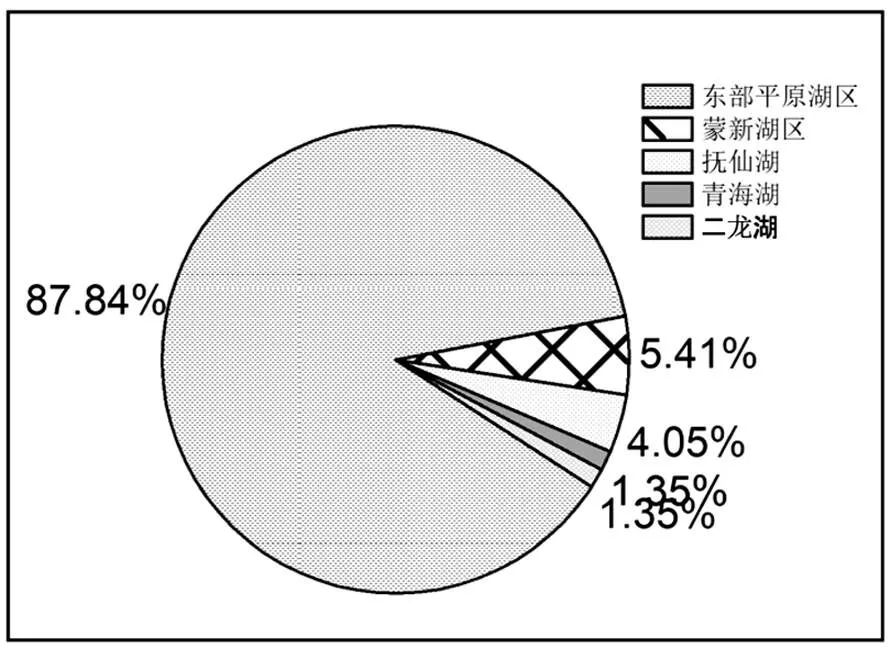
图1 中国不同湖区抗生素相关研究数量占比
2 典型湖泊水体抗生素污染特征
总体而言,东部平原湖区的抗生素污染水平高于其他湖区湖泊.东部平原湖区湖泊面积约占全国湖泊总面积的27.5%,是中国湖泊分布密度最大的地区之一.该区域内湖泊水深较浅,生物生产力较高,种群类型和生态系统较为复杂,受人类活动影响强烈,是中国湖泊抗生素现状研究涉及最多的区域.某一大类抗生素中的不同抗生素也会因为其不同的环境行为(例如,吸附,光解和生物降解效应)导致其检出频率不同,如NOR的检出率高于OFL[21].四大类抗生素的总污染水平高低顺序依次是Sas (2147ng/L)>QNs (1458ng/L)>TCs(481ng/L)>MLs(205ng/L).
2.1 磺胺类抗生素(SAs)污染特征
SAs具有抗菌谱广,价格低廉,化学性质稳定,使用方便等优点,被广泛用于牲畜养殖业中,是使用量最大的兽用抗菌药之一.调查表明常用的兽用SAs主要是磺胺嘧啶(SDZ),磺胺间甲氧嘧啶,磺胺二甲嘧啶,磺胺氯哒嗪,磺胺氯吡嗪等,其中SDZ使用量较高[22].SAs在水体中具有较好的溶解性和化学稳定性,是自然水环境中最常见的抗生素类药物.由于SAs的抑菌性较强,导致微生物对它的降解作用偏弱,在环境中主要通过化学降解,水解等非生物作用消减去除.在我国五大湖区的38个典型湖泊水体中均检出SAs,其中磺胺甲恶唑(SMX), SDZ,磺胺甲嘧啶(SMZ),磺胺塞唑(STZ)和甲氧苄氨嘧啶(TMP)为主要抗生素类型.湖泊水体中单种SA浓度范围为n.d.~771ng/L,不同湖泊水体中SAs总污染浓度依次为二龙湖(2017~2018年,771ng/L)>龙感湖(2018年,659ng/L)>太湖(2017年,577ng/L)>月湖(2017年,270ng/L)>洪湖(2015年,243ng/L)>鄱阳湖(2014~2015年,126ng/L);不同湖区SAs总平均污染浓度依次是东部平原湖区(1308ng/L)>二龙湖(771ng/L)>蒙新湖区(65.92ng/L)>青海湖(1.82ng/L)>抚仙湖(0.12ng/L)(表1).

表1 湖泊水体中主要磺胺类抗生素检出浓度范围(ng/L)
注:-:无检测数据;n.d.:低于检出限.
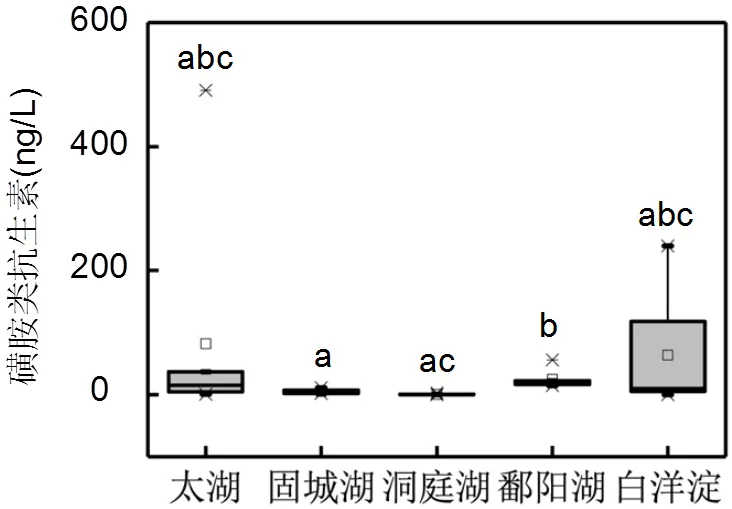
图2 典型湖泊水体中磺胺类抗生素的浓度比较
箱体上不同字母a,b和c代表p<0.05,即差异显著
如图2所示,在选取的5个典型湖泊中,SAs在固城湖与鄱阳湖及洞庭湖与鄱阳湖之间存在显著分布差异.SAs在湖泊水体中的高污染水平,与其在水产养殖中大量使用有关[47].Li等[48]于2017年6月(雨季),2017年10月(旱季)和2018年5月在二龙湖共采集了69个表层水体样品,分析了五种SAs的污染特征,发现SMX的浓度范围为67.85~2231ng/L,平均浓度为771ng/L,高于中国东北地区抗生素污染严重的饮马河流域.二龙湖总面积的40%以上为水产养殖区,且辽源市的生活污水和工业废水大部分出水排入二龙湖,这可能是二龙湖SMX严重污染的原因[46].相比河流中SMX的检出浓度(中国长江(2018年):3.86ng/L,巴西Barigui河(2019年):3.80 μg/L[49-50],中国湖泊中SMX污染水平较高.而在肯尼亚内罗毕河(2014年)的SMX检出浓度高达13800ng/L,与沿岸高人口密度,抗生素大量消费且生活污水直排入河有关[51].厦门市莲花水库中未检出SMX[52],大连市碧流河水库中检出较低浓度SMX(0~15ng/L)[53],以上两个水库均为饮用水源地,其低污染水平与水库周边较少的农业活动有关.根据美国食品和药物管理局报道,SMX在中国的生产规模和使用频率是世界上最高的,故SMX是需要重点关注的SAs类别[54].与太湖水体中TMP浓度(313ng/L)相比,海河流域(71.80ng/L)的TMP污染程度较轻[55].总体来看,中国湖泊中SAs污染水平可能与人口密度和人类活动强度相关[20,46,56],在人口密度相对东部平原湖区较低的蒙新湖区,青海湖和抚仙湖周围,SAs的污染水平较低.
2.2 四环素类抗生素(TCs)污染特征
TCs是由链霉菌产生的一类广谱抗生素,在化学结构上属于多环并四苯羧基酰胺母核的衍生物.TCs主要包括四环素(TCC),土霉素(OTC),金霉素(CTC)和强力霉素(DCC)等.TCs由于成本低廉,使用方便且具有广谱杀菌性及低毒性,被广泛应用于农业,畜牧业,在畜牧养殖中常作为抗病药物,生长促进剂等添加于饲料中.肯尼亚每年有14.6t的抗生素用于畜禽生产, 其中TCs占比为56%[57];TCs也是中国使用最多的药物添加剂,2003年中国仅OTC产量高达10000t,占世界OTC生产总量的65%[58].在重点关注的38个典型湖泊中,18个湖泊水体中检出了较高浓度的TCs,其中TCC, OTC, CTC和DCC为主要抗生素类别.湖泊水体中单种TC浓度范围为n.d.~2633ng/L, 不同湖泊的水体中TCs总污染浓度依次为太湖(2013年,3990ng/L)>洪湖(2015年,1254ng/L)>骆马湖(2019年,330ng/L)>鄱阳湖(2014~2015年,117ng/L)>巢湖(2012年,61.40ng/L);不同湖区TCs总平均污染浓度依次是东部平原湖区(465ng/L)>蒙新湖区(15.06ng/L)>青海湖(0.48ng/L)>抚仙湖(0.12ng/L)(表2).

表2 湖泊水体中四环素类主要检出浓度(ng/L)
注:-:无检测数据;n.d.:低于检出限.
如图3所示,在选取的5个典型湖泊中,TCs均无显著分布差异.Qin等[25]于2013年8月在引江济太工程引水期采集9个太湖贡湖湾的水样和5个入湖河流望虞河的水样,检测结果显示TCs浓度范围为1082~15310ng/L,平均浓度为3920±3479ng/L;相比望虞河,贡湖湾水体抗生素浓度较高,而引水工程对贡湖湾的抗生素污染负荷有一定的削减作用[25].贡湖湾北部湾中检测出微克级的TCs浓度与该区域城镇化程度较高有关,而作为人类疾病治疗常用抗生素,TCs在贡湖湾北部湾的使用量远高于贡湖湾南部湾的农村地区[59].

图3 典型湖泊中四环素类抗生素的浓度比较
箱体上不同字母a,b和c代表p<0.05,即差异显著
Xu等[20]于2017年1月,4月,7月和10月在太湖流域采集水体样品,对其中4种TCs进行测定,TCs浓度范围为0.10~83.80ng/L,远低于Qin等[25]在2013年的检测结果.与海洋和江河水体相比,渤海湾TCC浓度(2008年,n.d.~30ng/L)与白洋淀湖(2009年,27.7ng/L)相当[60],黄浦江(2009年,n.d.~114ng/L)介于洪湖与白洋淀湖之间[61].已有研究表明,进入动物体内的TCC大部分不能被机体完全吸收,经过代谢后仍有50%~80%以原药或者代谢物形式进入环境,这可能可以解释河湖水体中较高的TCC浓度[62].对于另两种TCs(OTC和CTC)而言,大部分湖泊中的OTC浓度低于长江(2012年,n.d.~22.5ng/L)和黄浦江(2012年,n.d.~219ng/ L)[63-64];而CTC在太湖和洪湖的污染浓度均较高,分别达到673ng/L和590ng/L,表明CTC可能是太湖流域和洪湖流域主要的TCs污染类型[59,65].城市湖泊水体中抗生素的浓度水平可以在一定程度上反映了湖泊周边区域抗生素的使用及排放特征[40].例如,位于武汉市区的南湖的DCC浓度高达20.43ng/L,高于另外两个武汉市区湖泊沙湖(11.30ng/L)和东湖(9.94ng/L)[40],南湖较高的DCC污染水平可能受到周边环境中医疗废水,工业污水,科研单位实验废水及居民生活污水等多种污染源的影响[66].
2.3 喹诺酮类抗生素(QNs)污染特征
QNs是一类人工合成的广谱类抗菌药,是喹诺酮的哌嗪基派生物,在治疗人和动物细菌性感染方面具有良好治疗效果.QNs的使用量位于抗感染药物前列,2009 年占据全球抗生素17%的市场份额[67]. WHO(1998年)调查显示[68],美国,日本,韩国和欧盟等国家和组织的年消费QNs约为120吨;而中国高达1820吨,其中诺氟沙星(NOR),环丙沙星(CIP)和氧氟沙星(OFX)的生产量最大[69].在重点关注的38个中国典型湖泊中,28个湖泊水体中有QNs检出,其中NOR,CIP,OFX,依诺沙星(ENO),恩诺沙星(ENR)和氟甲喹(FLU)为主要抗生素类别.湖泊水体中单种QN浓度范围为n.d.~2635ng/L,各湖泊水体中QNs总污染水平依次为白洋淀湖(2018年,3774ng/L)>二龙湖(2017~2018年,840ng/L)>太湖(2017年, 562ng/L)>巢湖(2012年,320ng/L)>月湖(2017年, 267ng/L)>南湖(2017年,105ng/L),不同湖区QNs总平均污染水平依次是二龙湖(840ng/L)>东部平原湖区(613ng/L)>蒙新湖区(59.12ng/L)>抚仙湖(3.40ng/L)>青海湖(0.74ng/L)(表3).

表3 湖泊水体中主要喹诺酮类检出浓度(ng/L)
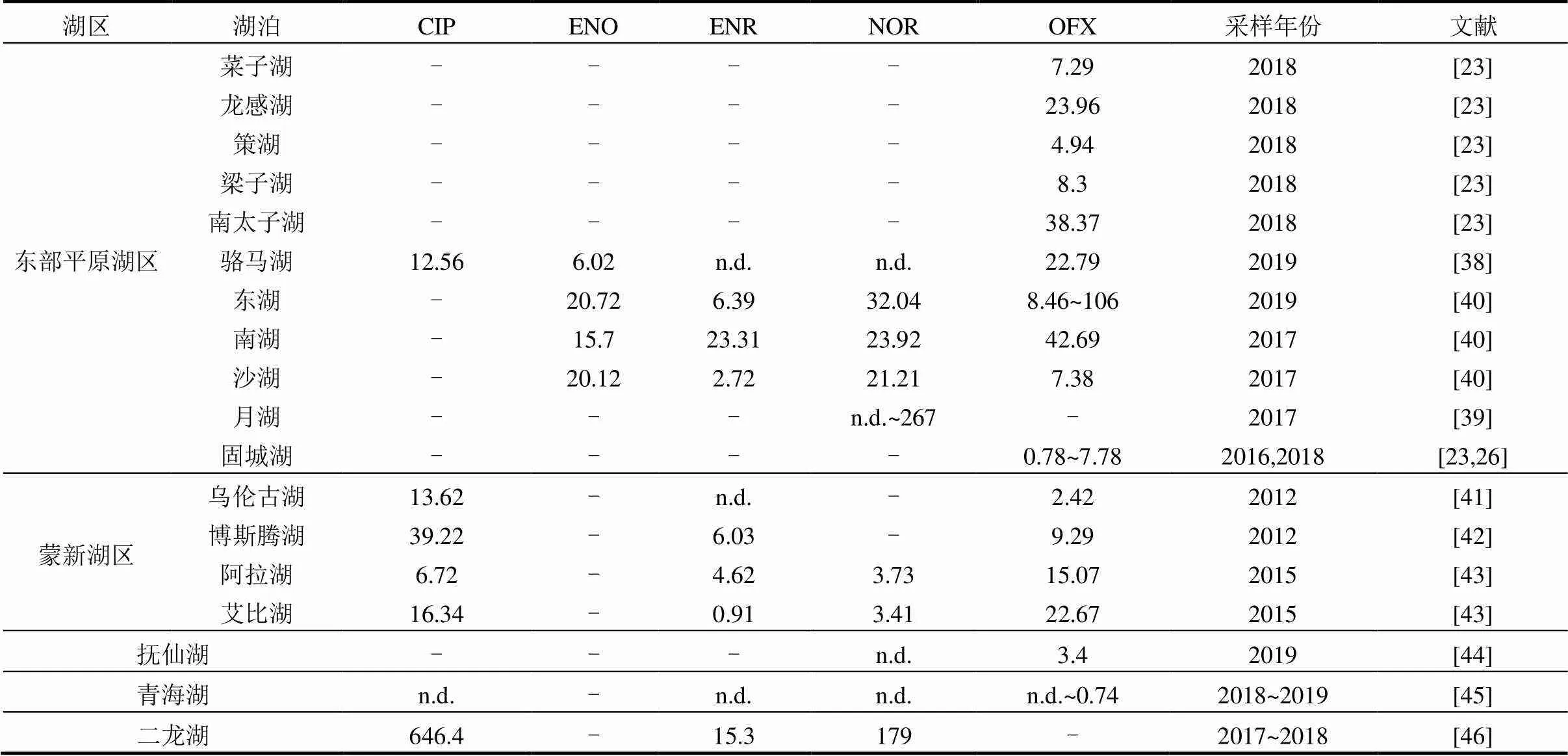
续表3
注:-:无检测数据;n.d.:低于检出限.
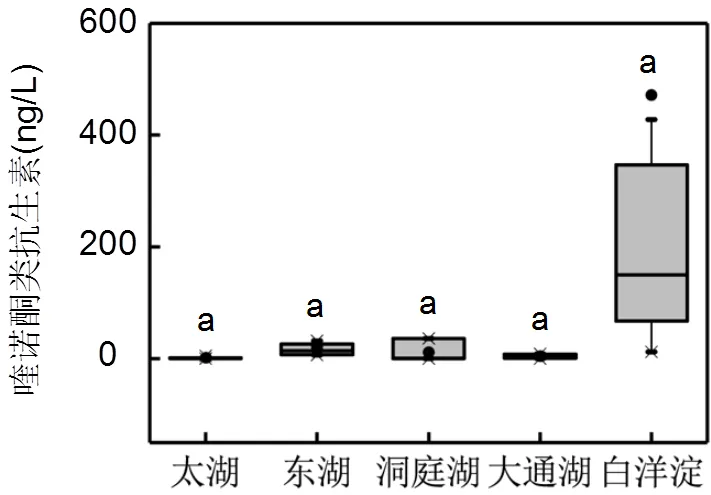
图4 典型湖泊中喹诺酮类抗生素的浓度比较
箱体上不同字母a,b和c代表p<0.05,即差异显著
如图4所示,在选取的5个典型湖泊中,QNs均无显著分布差异.王瑞杰等[39]在位于宁波市市中心的月湖中检测到QNs浓度高达267ng/L,可能与月湖周边人口密集区生活污水大量排放有关.相比太湖贡湖湾北部湾(331ng/L),南部湾检测的OFX浓度较高(474ng/L),这与南部湾农村人口居多,牲畜养殖业发达,且OFX作为人畜共用抗生素在该区域大量使用有关[59].Zhang等[33]发现白洋淀湖中存在较高的QNs生态风险,其中FLU(2635ng/L)检出浓度最高,这与当地的畜禽养殖业中FLU的广泛应用有关.尽管FLU在白洋淀等少数几个湖泊中高浓度检出,但相比其他QNs类型,FLU在38个典型湖泊中的检出频率较低,可能与FLU在水环境中易被光解和生物降解去除有关[21].对于另外两种QNs(CIP和NOR),相比欧洲河流水体中的检出浓度(CIP:513ng/L; NOR:33ng/L),我国东北平原与山地湖区的二龙湖(四平市饮用水源地)水体中CIP和NOR浓度较高,分别达到645ng/L和179ng/L[70],暗示QNs类抗生素在该区域可能存在潜在生态风险[46].
2.4 大环内酯类抗生素(MLs)污染特征
MLs是指链霉菌产生的广谱抗生素,具有基本的内酯环结构,对革兰阳性菌和革兰阴性菌均有抑制作用,尤其能有效杀灭支原体,衣原体,军团菌,螺旋体和立克次体,对治疗呼吸道感染发挥重要作用[86],主要用于人类疾病治疗[39].在38个典型湖泊中,MLs在19个湖泊水体中检出,其中红霉素(ETM),罗红霉素(RTM),阿奇霉素(ATM)和泰乐菌素(TYL)是主要的抗生素类别.相比SAs, TCs和QNs, MLs在湖泊水体中的检出浓度最低,这可能与其高疏水性,强亲脂性以及沉积物对MLs的强吸附性有关[71].湖泊水体中单种ML浓度范围为n.d.~566ng/L,各湖泊水体中MLs总污染水平依次为骆马湖(2019年,644ng/L)>淀山湖(2018年,564ng/L)>太湖(2017年,432ng/L)>月湖(2017年,227ng/L)>东湖(2017年,195ng/L)>巢湖(2012年,136ng/L),不同湖区MLs总平均污染水平依次是东部平原湖区(197ng/L)>蒙新湖区(5.28ng/L)>抚仙湖(2.25ng/L)>青海湖(0.61ng/L)(表4).
如图5所示,在选取的5个典型湖泊中,MLs在洞庭湖与鄱阳湖之间存在显著分布差异.杨宇轩等[38]对骆马湖及其入湖河流表层水体中的MLs的调查结果显示,湖区RTM的最高浓度高达566ng/L.同时在太湖水体中检测出了较高浓度的RTM (60.2ng/L),与莲花水库浓度相当(72.58ng/L),而其余湖泊的污染水平与河流水体一致,比如海河(2008年,n.d.~12ng/L),松花江(2016年,0.2~11.5ng/L)和位于韩国的汉江(2005年,3~14ng/L)[72-74].在淀山湖中检出了最高浓度的ETM(564ng/L),可能与淀山湖周边存在的污染源如医院等有关[23].ETM在长江中下游三大淡水湖泊(太湖,洞庭湖和巢湖)中的浓度分别为0.07~1139ng/L,0.26~182ng/L和1.57~136ng/L,明显高于长江水体(8~24ng/L)[23,75].而对位于云贵高原湖区的抚仙湖的研究表明,靠近居民区的采样点的抗生素浓度最高,其次为采矿区,农业区和游客区,与青海湖不同的是,抚仙湖流入河流中的MLs平均浓度是湖泊中MLs的5.6倍,这可能与水体稀释作用和抗生素降解有关[44].

表4 湖泊水体中主要大环内酯类检出浓度(ng/L)
注:-:无检测数据;n.d.:低于检出限.
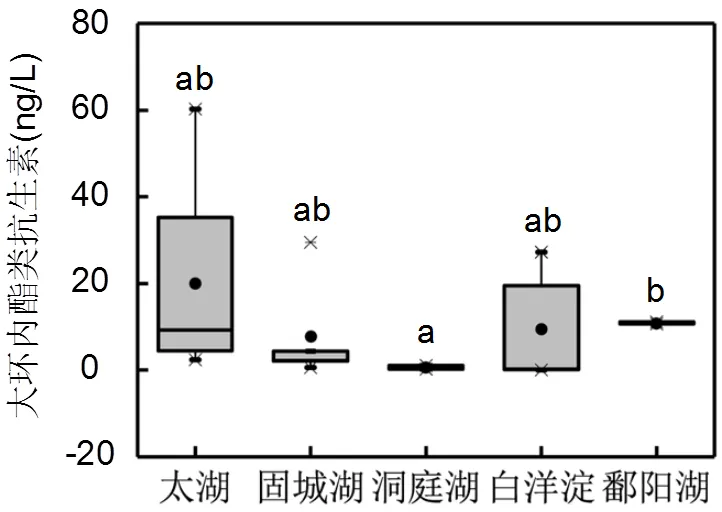
图5 典型湖泊中大环内酯类抗生素的浓度比较
箱体上不同字母a,b和c代表p<0.05,即差异显著
3 典型湖泊沉积物中抗生素污染特征
相比湖泊水体中抗生素污染水平,关于湖泊沉积物中抗生素的报道相对较少,已有文献主要关注东部平原湖区和蒙新湖区.总体来说,湖泊沉积物中TCs和QNs的浓度水平明显高于水体,检出浓度均达微克级,这可能与沉积物颗粒对QNs和TCs的强吸附性有关,其中TCs可利用阳离子吸附架桥作用对沉积物中的有机质有较高亲和力[76-77].QNs与阳离子具有很强的螯合作用,延缓了它们在沉积物中的降解过程[36],进一步导致 QNs 在沉积物中的残留浓度较高.在土壤/沉积物环境中,SAs及其代谢产物不易发生降解,会长期存在并积累于沉积物中[78],这可能是SAs在沉积物环境中的检出浓度较高的原因.在重点关注的38个典型湖泊中,9个湖泊沉积物中检出了一定浓度的抗生素,其中ETM, OFX, TCC和SDZ为主要抗生素类别.湖泊沉积物中单种抗生素浓度范围为n.d.~2663ng/g,各湖泊沉积物中抗生素的总污染水平依次为(2015年,3888ng/g)>白洋淀湖(2018年,1623ng/g)>博斯腾湖(2012年,391ng/g)>太湖(2017年,272ng/g)>南四湖(2017年,22.43ng/g),不同湖区沉积物中抗生素总平均污染水平高低顺序依次是东部平原湖区(901ng/g)>蒙新湖区(391ng/g)(表5).

表5 湖泊沉积物中主要检出抗生素及浓度(ng/g)
注:-:无检测数据;n.d.:低于检出限.
Okugbe等[80]对比了城乡湖泊(太湖,玄武湖,五龙潭)沉积物中7种抗生素的垂直分布规律,结果表明太湖抗生素总浓度高于玄武湖和五龙潭,表层沉积物抗生素浓度基本高于深层,且抗生素浓度一般随沉积物深度的增加而降低.可能原因为在持续的点源和面源污染下,湖泊附近医疗废水和生活污水从地表径流再到湖泊,使得湖泊表层沉积物汇集了大量抗生素,同时在湖泊沉积物内抗生素的移动或再分配率较低[81].而Li等[45]对青海湖及其入湖河流沉积物样本中的83种目标抗生素等微污染物进行定量分析,包括抗生素的降解产物;研究表明由于红霉素的降解产物AETM的Kd值最大,即具有高吸附性和强疏水性,使其在沉积物中占主导地位[45].
洪湖沉积物中SAs总浓度高达706ng/g,可能与洪湖广泛的水产养殖面积相关.中国珠江(n.d.~ 3.24ng/g)和美国Choptank River(n.d.~0.82ng/g)中SAs浓度低于10ng/g,低于中国湖泊沉积物中SAs浓度[82,83].在白洋淀湖的沉积物中检测出了较高浓度的OFX(260ng/g),明显高于美国明尼苏达州的湖泊[84](2014年,66.10ng/g)和美国的密歇根湖[85](2009~2010年,7.7ng/g)沉积物中的OFX浓度.据Li等报道[86],新疆畜牧业发达,而大部分农场又远离城市无基本污水处理设施,导致大量残余抗生素的废水排入自然环境,进一步富集至湖泊沉积物中.在属于蒙新湖区的博斯腾湖表层沉积物中发现QNs类占主导地位,尤其是CIP(213ng/g);同时靠近城区和河口的沉积物采样点中抗生素污染浓度普遍偏高,与水体结果一致[42].Zhang等[87]发现QNs的高污染水平可能由于其为某些抗生素分解的副产物,同时抗生素的降解产物可能比母体抗生素毒性更大,加剧抗生素污染的严重性[88-89].在洪湖沉积物中检出了微克级浓度的TCC(2663ng/g),远高于三峡库区长寿湖中TCC浓度(12.81ng/g)[90];同样也在洪湖沉积物中检出了较高浓度OTC和CTC,分别为68.45和438ng/g,进一步表明人类活动对洪湖沉积物生态环境造成了影响[56].而河北石家庄汪洋河沉积物中TCC浓度(4.23~16799ng/g)远高于中国湖泊[91],可能由于该河流为河北高新技术产业开发区污水处理系统出水的唯一接收水体.MLs在湖泊沉积物中的低检出浓度可能与该药物主要用于人类疾病治疗有关[10].其中ETM在湖泊沉积物中的最高浓度为27.7ng/g(太湖),低于海河沉积物(67.7ng/g)和黄河沉积物(49.8ng/g)[73].
4 典型湖泊抗生素污染的季节性差异
在同一湖泊中抗生素的浓度往往呈现季节差异,以东部平原湖区的典型湖泊太湖为例.对太湖抗生素浓度的实地调查已有多篇报道,但其不同季节的污染水平差异或相似性仍有待阐明.Xu等[20]对太湖流域4个季节的四大类抗生素时空分布特征进行了调查研究,结果表明太湖流域季节差异性明显,春,夏,冬季的污染量显著高于秋季.抗生素在不同季节的分布差异可能是由于非生物因素导致的,例如流体动力条件,风向和风速[92].且其一般是多个外部驱动因素的协同作用导致,例如降雨既可能加剧污染——大量雨水驱动地表径流,而这些径流可能携带抗生素进入接收河流或湖泊,又可能是雨水汇入河湖,起到稀释水体抗生素浓度的作用[92].抗生素在夏季的生物降解和光解作用比其他季节更强烈;但在夏季高温时病原微生物更活跃,为了促进畜禽生长或防治畜禽感染疾病,畜禽和水产养殖业中抗生素的使用量可能增加[93].白洋淀旱季(4月)和雨季(8月)QNs含量的研究结果与上述太湖的研究结果相反,旱季抗生素浓度整体高于雨季[94],故降雨对抗生素起到了稀释作用,这与对鄱阳湖,二龙湖的研究结果一致[46,95].而对固城湖地表水中邻近河川和蟹塘的水体抗生素进行季节性检测发现,固城湖水体抗生素浓度存在明显的季节性变化,且夏季抗生素浓度最高[26].位于蒙新湖区的乌伦古湖抗生素分布主要受周边河流水文和气候条件变化影响,导致抗生素在枯水期含量普遍高于丰水期[41].鉴于湖泊沉积物受温度和降雨的影响程度相对湖泊水体偏低且抗生素在沉积物中迁移性较差[96],沉积物中抗生素季节性差异较水体并不明显,还需考虑湖泊底泥扰动时抗生素释放至上覆水中的复杂情况.
5 结语
基于文献资料数据,系统分析了跨越14个省份与直辖市的中国不同湖区共38个典型湖泊中的四大类抗生素的污染特征.中国湖泊中抗生素污染较为普遍;受人类活动干扰大的湖泊污染程度较重,典型代表为太湖,洪湖,二龙湖及博斯腾湖,其水体和沉积物中TCs和SAs均被高浓度检出,需重点关注;大部分湖泊水体旱季抗生素污染水平高于雨季,靠近污染源地区的污染水平较高,表层沉积物抗生素浓度基本高于深层沉积物.然而,中国湖泊抗生素研究仍存在以下不足:湖泊水体及沉积物中抗生素组分复杂,已有研究大多选择某几种抗生素进行探讨,缺乏对抗生素全貌的研究,且监测手段缺乏时效性.已有研究大部分只考虑湖泊水体或沉积物,并未同时检测入,出湖河流的污染情况,对于不同湖泊不同时间的抗生素污染情况难以进行对比.目前研究区域局限于东部平原湖区,其他四大湖区的研究数据较为薄弱.目前研究主要针对湖泊水体和沉积物中的抗生素污染情况,缺乏对湖泊中生物体内抗生素的赋存和影响研究.
针对以上不足,未来研究应从以下几方面展开:加大自然环境中抗生素监测技术的研发投入力度,以期可实时监测湖泊中抗生素浓度动态变化.加大对受人类干扰影响较小地区湖泊的关注力度,确定自然湖泊中抗生素背景浓度值,以期界定严重污染湖泊.为湖泊环境介质制定抗生素的最大阈值,明确抗生素等新型污染物的环境标准.针对湖泊中生物体内抗生素浓度含量开展研究,了解抗生素的水生生物毒理特性.
[1] Andersson D I, Hughes D. Microbiological effects of sublethal levels of antibiotics [J]. Nature Reviews Microbiology, 2014,12(7):465-478.
[2] Ben Y J, Fu C X, Hu M, et al. Human health risk assessment of antibiotic resistance associated with antibiotic residues in the environment: A review [J]. Environmental Research, 2019,169(2): 483-493.
[3] Zhang Q Q, Ying G G, Pan C G, et al. Comprehensive evaluation of antibiotics emission and fate in the river basins of China: Source analysis, multimedia modeling, and linkage to bacterial resistance [J]. Environmental science & Technology, 2015,49(11):6772-6782.
[4] 孙金昭.城市生活垃圾填埋场中抗生素残留浓度征及抗性基因相关性研究 [D]. 上海:华东师范大学, 2017.
Sun J Z. Characteristics of antibiotics contents in municipal solid waste landfills and correlation with antibiotic resistance genes [D]. Shanghai: East China Normal University, 2017.
[5] Wang J L, Zhuan R, Chu L B. The occurrence, distribution and degradation of antibiotics by ionizing radiation: An overview [J]. Science of the Total Environment, 2019,646(1):1385-1397.
[6] Hartmann A, Alder A C, Koller T, et al. Identification of fluoroquinolone antibiotics as the main source of umuC genotoxicity in native hospital wastewater [J]. Environmental Toxicology & Chemistry, 2010,17(3):377-382.
[7] 徐 艳,张 远,郭昌胜,等.石家庄汪洋沟地区抗生素,抗性细菌和抗性基因污染特征 [J]. 农业环境科学学报, 2014,33(6):1174-1182.
Xu Y, Zhang Y, Guo C S, et al. Pollution characteristics of antibiotics and antibiotic-resistant bacteria and genes in Wangyanggou River, Shijiazhuang, China [J]. Journal of Agro-Environment Science, 2014, 33(6):1174-1182.
[8] Jacobsen P L, Berglind L. Persistence of oxytetracycline in sediments from fish farms [J]. Aquaculture, 1988,70(4):365-370.
[9] Samuelsen O B. Degradation of oxytetracycline in seawater at two different temperatures and light intensities, and the persistence of oxytetracycline in the sediment from a fish farm [J]. Aquaculture, 1989,83(1/2):7-16.
[10] 刘 洁.三峡库区典型支流沉积物中抗生素及抗性基因多样性研究 [D]. 重庆:重庆大学, 2019.
Liu J. Study on diversity of antibiotics and resistance genes in typical tributary sediments from the Three Gorges Reservoir [D]. Chongqing: Chongqing University, 2019.
[11] Murata A, Takada H, Mutoh K, et al. Nationwide monitoring of selected antibiotics: Distribution and sources of sulfonamides, trimethoprim, and macrolides in Japanese rivers [J]. Science of the Total Environment, 2011,409(24):5305-5312.
[12] Xu W H, Yan W, Li X D, et al. Antibiotics in riverine runoff of the Pearl River Delta and Pearl River Estuary, China: Concentrations, mass loading and ecological risks [J]. Environmental Pollution, 2013, 182(6):402-407.
[13] Xu W H, Zhang G, Zou S C, et al. A preliminary investigation on the occurrence and distribution of antibiotics in the Yellow River and its tributaries, China [J]. Water Environment Research, 2009,81(3):248.
[14] Xu J, Zhang Y, Zhou C B, et al. Distribution, sources and composition of antibiotics in sediment, overlying water and pore water from Taihu Lake, China [J]. Science of the Total Environment, 2014,497-498: 267-273.
[15] Tang J, Shi T Z, Wu X W, et al. The occurrence and distribution of antibiotics in Lake Chaohu, China: Seasonal variation, potential source and risk assessment [J]. Chemosphere, 2015,122:154-161.
[16] Zhang R J, Zhang G, Zheng Q, et al. Occurrence and risks of antibiotics in the Laizhou Bay, China: Impacts of river discharge [J]. Ecotoxicology and Environmental Safety, 2012,80(2):208-215.
[17] Zhang R J, Tang J H, Li J, et al. Antibiotics in the offshore waters of the Bohai Sea and the Yellow Sea in China: Occurrence, distribution and ecological risks [J]. Environmental Pollution, 2013,174(3):71-77.
[18] Yang J F, Ying G G, Zhao J L, et al. Spatial and seasonal distribution of selected antibiotics in surface waters of the Pearl Rivers, China [J]. Journal of Environmental Science & Health Part B, 2011,46(3): 272-280.
[19] Luo Y, Xu L, Rysz M, et al. Occurrence and transport of tetracycline, sulfonamide, quinolone, and macrolide antibiotics in the Haihe River Basin, China [J]. Environmental Science & Technology, 2011,45(5): 1827-1833.
[20] Xu Z A, Li T, Bi J, et al. Spatiotemporal heterogeneity of antibiotic pollution and ecological risk assessment in Taihu Lake Basin, China [J]. Science of the Total Environment, 2018,643:12-20.
[21] Yang J F, Ying G G, Zhao J L, et al. Simultaneous determination of four classes of antibiotics in sediments of the Pearl Rivers using RRLC-MS/MS [J]. Science of the Total Environment, 2010,408(16): 3424-3432.
[22] Kim K R, Owens G, Kwon S I, et al. Occurrence and environmental fate of veterinary antibiotics in the terrestrial environment [J]. Water Air and Soil Pollution, 2011,214(1-4):163-174.
[23] Li L, Liu D, Zhang Q, et al. Occurrence and ecological risk assessment of selected antibiotics in the freshwater lakes along the middle and lower reaches of Yangtze River Basin [J]. Journal of Environmental Management, 2019,249:109396.
[24] Yan Z H, Yang H H, Dong H K, et al. Occurrence and ecological risk assessment of organic micropollutants in the lower reaches of the Yangtze River, China: A case study of water diversion [J]. Environmental Pollution, 2018,239:223-232.
[25] Qin Y W, Wen Q, Ma Y Q, et al. Antibiotics pollution in Gonghu Bay in the period of water diversion from Yangtze River to Taihu Lake [J]. Environmental Earth Sciences, 2018,77(11):419.1-419.11.
[26] Wang W X, Zhou L J, Gu X H, et al. Occurrence and distribution of antibiotics in surface water impacted by crab culturing: A case study of Lake Guchenghu, China [J]. Environmental Science and Pollution Research, 2018,25(23):22619-22628.
[27] 唐 俊,陈海燕,史陶中,等.巢湖喹诺酮及四环素类药物污染现状及来源分析 [J]. 安徽农业大学学报, 2013,40(6):1043-1048.
Tang J, Chen H Y, Shi T Z, et al. Occurrence of quinolones and tetracyclines antibiotics in the aquatic environment of Chaohu Lake [J]. Journal of Anhui Agricultural University, 2013,40(6):1043-1048.
[28] Han M Z, Dsouza M, Zhou C Y, et al. Agricultural risk factors influence microbial ecology in Honghu Lake [J]. Genomics Proteomics & Bioinformatics, 2019,17(1):76-90.
[29] Wang Y Q, Liu Y, Lu S Y, et al. Occurrence and ecological risk of pharmaceutical and personal care products in surface water of the Dongting Lake, China-during rainstorm period [J]. Environmental Science and Pollution Research, 2019,26(28):28796-28807.
[30] Zhou L J, Li J, Zhang Y, et al. Trends in the occurrence and risk assessment of antibiotics in shallow lakes in the lower-middle reaches of the Yangtze River basin, China [J]. Ecotoxicology and Environmental Safety, 2019,183:109511.
[31] 刘晓晖,卢少勇.大通湖表层水体中抗生素赋存特征与风险 [J]. 中国环境科学, 2018,38(1):320-329.
Liu X H, Lu S Y. Occurrence and ecological risk of typical antibiotics in surface water of the Datong Lake, China [J]. China Environmental Science, 2018,38(1):320-329.
[32] Ding H J, Wu Y X, Zhang W H, et al. Occurrence, distribution, and risk assessment of antibiotics in the surface water of Poyang Lake, the largest freshwater lake in China [J]. Chemosphere, 2017,184:137-147.
[33] Zhang L L, Shen L N, Qin S, et al. Quinolones antibiotics in the Baiyangdian Lake, China: Occurrence, distribution, predicted no- effect concentrations (PNECs) and ecological risks by three methods [J]. Environmental Pollution, 2020,256(1):113458.1-113458.9.
[34] Zhang P W, Zhou H D, Li K, et al. Occurrence of pharmaceuticals and personal care products, and their associated environmental risks in a large shallow lake in North China [J]. Environmental Geochemistry and Health, 2018,40(4):1525-1539.
[35] Cheng D M, Liu X H, Wang L, et al. Seasonal variation and sediment-water exchange of antibiotics in a shallower large lake in North China [J]. Science of the Total Environment, 2014,476:266-275.
[36] Li W H, Shi Y L, Gao L H, et al. Occurrence of antibiotics in water, sediments, aquatic plants, and animals from Baiyangdian Lake in North China [J]. Chemosphere, 2012,89(11):1307-1315.
[37] Zhang G D, Liu X H, Lu S Y, et al. Occurrence of typical antibiotics in Nansi Lake's inflowing rivers and antibiotic source contribution to Nansi Lake based on principal component analysis-multiple linear regression model [J]. Chemosphere, 2020,242(12):52-69.
[38] 杨宇轩.骆马湖表层水典型抗生素赋存特征及沉积物吸附行为研究 [D]. 徐州:中国矿业大学, 2020.
Yang Y X. Occurrence characteristics of typical antibiotics in surface water of Luoma Lake and adsorption behavior on sediments [D]. Xuzhou: China University of Mining and Technology, 2020.
[39] 王瑞杰,裘钱玲琳,李国祥,等.宁波月湖水体中抗生素分布与生态风险评价 [J]. 湖泊科学, 2018,30(6):1616-1624.
Wang R J, QiuQian L L, Li G X, et al. Distribution characteristics and ecological risk assessment of selected antibiotics in Moon Lake, Ningbo City [J]. Journal of Lake Sciences, 2018,30(6):1616-1624.
[40] 肖鑫鑫,吴亦潇,丁惠君,等.武汉城市湖泊抗生素及抗性基因的污染特征研究 [J]. 环境科学与技术, 2019,42(3):9-16.
Xiao X X, Wu Y X, Ding H J, et al. Pollution characteristics of antibiotics and antibiotic resistance genesin urban lakes of Wuhan [J]. Environmental Science & Technology, 2019,42(3):9-16.
[41] 雷晓宁.新疆典型湖泊中抗生素的污染状况与分布特征 [D]. 石河子:石河子大学, 2014.
Lei X N. Distribution and pollution levels of antibiotics from typical lakes in Xinjiang [D]. Shihezi: Shihezi University, 2014.
[42] Lei X N, Lu J J, Liu Z L, et al. Concentration and distribution of antibiotics in water-sediment system of Bosten Lake, Xinjiang [J]. Environmental Science and Pollution Research, 2015,22(3):1670- 1678.
[43] 王倩倩.新疆阿拉山口及周边水环境中多种抗生素的污染水平研究 [D]. 石河子:石河子大学, 2016.
Wang Q Q. Pollution levels of antibiotics from aquatic environment in Alashankou Region of Xinjiang and surrounding area [D]. Shihezi: Shihezi University, 2016.
[44] Zhao B, Xu J M, Zhang G D, et al. Occurrence of antibiotics and antibiotic resistance genes in the Fuxian Lake and antibiotic source analysis based on principal component analysis-multiple linear regression model [J]. Chemosphere, 2020,262:127741.
[45] Li S, Kuang Y Z, Hu J R, et al. Enrichment of antibiotics in an inland lake water [J]. Environmental Research, 2020,190:110029.
[46] Li S J, Ju H Y, Zhang J Q, et al. Occurrence and distribution of selected antibiotics in the surface waters and ecological risk assessment based on the theory of natural disaster [J]. Environmental Science and Pollution Research, 2019,26(27):28384-28400.
[47] 王 娜.环境中磺胺类抗生素及其抗性基因的污染特征及风险研究 [D]. 南京:南京大学, 2014.
Wang N. Pollution characteristics and risk of sulfonamides antibiotics and their resistance genes in the environment [D]. Nanjing: Nanjing University, 2014.
[48] Li S J, Ju H Y, et al. Terrestrial humic-like fluorescence peak of chromophoric dissolved organic matter as a new potential indicator tracing the antibiotics in typical polluted watershed [J]. Journal of Environmental Management, 2018,228(12.15):65-76.
[49] Zhang G D, Lu S Y, Wang Y Q, et al. Occurrence of antibiotics and antibiotic resistance genes and their correlations in lower Yangtze River, China [J]. Environmental Pollution, 2020,257:113365.
[50] Böger B, Surek M, Vilhena R d O, et al. Occurrence of antibiotics and antibiotic resistant bacteria in subtropical urban rivers in Brazil [J]. Journal of Hazardous Materials, 2021,402:123448.
[51] Ngumba E, Gachanja A, Tuhkanen T. Occurrence of selected antibiotics and antiretroviral drugs in Nairobi River Basin, Kenya [J]. Science of the Total Environment, 2016,539:206-213.
[52] 廖 杰,魏晓琴,肖燕琴,等.莲花水库水体中抗生素污染特征及生态风险评价 [J]. 环境科学, 2020,41(9):205-211.
Liao J, Wei X Q, Xiao Y Q, et al. Pollution characteristics and risk assessment of antibiotics in Lianhua Reservoir [J]. Environmental Science, 2020,41(9):205-211.
[53] 董莞莞,何 欣,郑洪波,等.大连碧流河水库及河流典型抗生素污染和分布特征研究 [J]. 大连理工大学学报, 2020,60(2):119-127.
Dong W W, He X, Zhen H B, et al. Research on occurrences and distribution characteristics of typical antibiotics in Biliuhe Reservoir and its inflow rivers in Dalian [J]. Journal of Dalian University of Technology, 2020,60(2):119-127.
[54] Liu X H, Lu S Y, Guo W, et al. Antibiotics in the aquatic environments: A review of lakes, China [J]. Science of the Total Environment, 2018, 627:1195-1208.
[55] Lei K, Zhu Y, Chen W, et al. Spatial and seasonal variations of antibiotics in river waters in the Haihe River Catchment in China and ecotoxicological risk assessment [J]. Environment International, 2019, 130:104919.
[56] Wang Z, Han M Z, Li E H, et al. Distribution of antibiotic resistance genes in an agriculturally disturbed lake in China: Their links with microbial communities, antibiotics, and water quality [J]. Journal of Hazardous Materials, 2020,393:122426.
[57] Sarmah A K, Meyer M T, Boxall A B A. A global perspective on the use, sales, exposure pathways, occurrence, fate and effects of veterinary antibiotics (VAs) in the environment [J]. Chemosphere, 2006,65(5):725-759.
[58] 安清聪,张 曦,陈克嶙.动物组织中四环素类抗生素残留的ELISA检测研究-土霉素抗体的制备 [J]. 畜牧与兽医, 2004,36(9):8-10.
An Q C, Zhang X, Chen K L. Detection of tetracyclines residue in animal tissues by ELISA: Preparation of anti-OTC antibodies [J]. Animal Husbandry & Veterinary Medicine, 2004,36(9):8-10.
[59] 武旭跃,邹 华,朱 荣,等.太湖贡湖湾水域抗生素污染特征分析与生态风险评价 [J]. 环境科学, 2016,37(12):4596-4604.
Wu Y H, Zou H, Zhu R, et al. Occurrence, distribution and ecological risk of antibiotics in surface water of the Gonghu Bay, Taihu Lake [J]. Environmental Science, 2016,37(12):4596-4604.
[60] Zou S C, Xu W H, et al. Occurrence and distribution of antibiotics in coastal water of the Bohai Bay, China: Impacts of river discharge and aquaculture activities [J]. Environmental Pollution, 2011,159(10): 2913-2920.
[61] Jiang L, Hu X L, Yin D Q, et al. Occurrence, distribution and seasonal variation of antibiotics in the Huangpu River, Shanghai, China [J]. Chemosphere, 2011,82(6):822-828.
[62] 罗方园,潘根兴,李恋卿,等.洪泽湖沉积物中四环素土霉素及相关抗性基因的分布特征及潜在风险分析 [J]. 农业环境科学学报, 2017, 36(2):369-375.
Luo F Y, Pan G X, Li L Q, et al. The distribution characteristics and potential risk of tetracycline, oxytetracycline and their corresponding genes pollution in sediment ofHongze Lake [J]. Journal of Agro- Environment Science, 2017,36(2):369-375.
[63] Yan C X, Yang Y, Zhou J L, et al. Antibiotics in the surface water of the Yangtze Estuary: Occurrence, distribution and risk assessment [J]. Environmental Pollution, 2013,175(4):22-29.
[64] Chen K, Zhou J L. Occurrence and behavior of antibiotics in water and sediments from the Huangpu River, Shanghai, China [J]. Chemosphere, 2014,95(6):604-612.
[65] Tong L, Qin L T, Guan C, et al. Antibiotic resistance gene profiling in response to antibiotic usage and environmental factors in the surface water and groundwater of Honghu Lake, China [J]. Environmental Science and Pollution Research, 2020,27(25):31995-32005.
[66] Yang Y Y, Xu C, Cao X H, et al. Antibiotic resistance genes in surface water of eutrophic urban lakes are related to heavy metals, antibiotics, lake morphology and anthropic impact [J]. Ecotoxicology, 2017, 26(6):831-840.
[67] Hamad B. The antibiotics market [J]. Nature Reviews Drug Discovery, 2010,9(9):675-676.
[68] Units T. Use of quinolones in food animals and potential impact on human health [A]. 1998.
[69] Sukul P, Spiteller M. Fluoroquinolone antibiotics in the environment [J]. Reviews of Environmental Contamination and Toxicology, 2007, 191:131-162.
[70] Zuccato E, Castiglioni S, Bagnati R, et al. Source, occurrence and fate of antibiotics in the Italian aquatic environment [J]. Journal of Hazardous Materials, 2010,179(1-3):1042-1048.
[71] Yue J, Cong X, Wang X Y, et al. Occurrence, seasonal variation and risk assessment of antibiotics in Qingcaosha Reservoir [J]. Water, 2018,10(2):115.
[72] Choi K, Kim Y, Park J, et al. Seasonal variations of several pharmaceutical residues in surface water and sewage treatment plants of Han River, Korea [J]. Science of the Total Environment, 2008, 405(1-3):120-128.
[73] Zhou L J, Ying G G, Zhao J L, et al. Trends in the occurrence of human and veterinary antibiotics in the sediments of the Yellow River, Hai River and Liao River in northern China [J]. Environmental Pollution, 2011,159(7):1877-1885.
[74] Wang W H, Wang H, Zhang W F, et al. Occurrence, distribution, and risk assessment of antibiotics in the Songhua River in China [J]. Environmental Science and Pollution Research, 2017,24(23):1-11.
[75] Chang X, Meyer M T, Liu X, et al. Determination of antibiotics in sewage from hospitals, nursery and slaughter house, wastewater treatment plant and source water in Chongqing region of Three Gorges Reservoir in China [J]. Environmental Pollution, 2010,158(5):1444- 1450.
[76] Figueroa R A, Leonard A, Mackay A A. Modeling tetracycline antibiotic sorption to clays [J]. Environmental Science & Technology, 2004,38(2):476-483.
[77] Zhang J Q, Dong Y H. Effect of low-molecular-weight organic acids on the adsorption of norfloxacin in typical variable charge soils of China [J]. Journal of Hazardous Materials, 2008,151(2/3):833-839.
[78] 汪仙仙,张洪昌,沈根祥,等.典型磺胺类抗生素在稻田土中的纵向迁移 [J]. 环境化学, 2018,37(8):71-79.
Wang X X, Zhang H C, Shen G X, et al. Vertical migration of typical sulfonamide antibiotics in paddy soil [J]. Environmental Chemistry, 2018,37(8):71-79.
[79] Xie Z X, Lu G H, Yan Z H, et al. Bioaccumulation and trophic transfer of pharmaceuticals in food webs from a large freshwater lake [J]. Environmental Pollution, 2017,222:356-366.
[80] Ohore O E, Addo F G, Han N N, et al. Profiles of ARGs and their relationships with antibiotics, metals and environmental parameters in vertical sediment layers of three lakes in China [J]. Journal of Environmental Management, 2020,255(2):109583.1-109583.12.
[81] Zhang S H, Pang S, Wang P F, et al. Antibiotic concentration and antibiotic-resistant bacteria in two shallow urban lakes after stormwater event [J]. Environmental Science and Pollution Research, 2016,23(10):9984-9992.
[82] Arikan O A, Rice C, Codling E. Occurrence of antibiotics and hormones in a major agricultural watershed [J]. Desalination, 2008, 226(1-3):121-133.
[83] Liang X M, Chen B W, Nie X P, et al. The distribution and partitioning of common antibiotics in water and sediment of the Pearl River Estuary, South China [J]. Chemosphere, 2013,92(11):1410-1416.
[84] Kerrigan J F, Sandberg K D, Engstrom D R, et al. Sedimentary record of antibiotic accumulation in Minnesota Lakes [J]. Science of the Total Environment, 2018,621:970-979.
[85] Blair B D, Crago J P, Hedman C J, et al. Pharmaceuticals and personal care products found in the Great Lakes above concentrations of environmental concern [J]. Chemosphere, 2013,93(9):2116-2123.
[86] 李 超.新疆地区典型污染源抗生素抗性基因的污染分布的研究分析 [D]. 石河子:石河子大学, 2016.
Li C. Distribution and contamination levels of ARGs from typical pollution sources in Xinjiang [D]. Shihezi: Shihezi University, 2016.
[87] Zhang S H, Gu J, Wang C, et al. Characterization of antibiotics and antibiotic resistance genes on an ecological farm system [J]. Journal of Chemistry, 2015,2015:1-8.
[88] Yan M T, Xu C, Huang Y M, et al. Tetracyclines, sulfonamides and quinolones and their corresponding resistance genes in the Three Gorges Reservoir, China [J]. Science of the Total Environment, 2018, 631-632:840-848.
[89] Leung H W, Minh T B, Murphy M B, et al. Distribution, fate and risk assessment of antibiotics in sewage treatment plants in Hong Kong, South China [J]. Environment International, 2012,42(1):1-9.
[90] Lu L H, Liu J, Li Z, et al. Antibiotic resistance gene abundances associated with heavy metals and antibiotics in the sediments of Changshou Lake in the Three Gorges Reservoir area, China [J]. Ecological Indicators, 2020,113:106275.
[91] Jiang Y H, Li M X, Guo C S, et al. Distribution and ecological risk of antibiotics in a typical effluent–receiving river (Wangyang River) in north China [J]. Chemosphere, 2014,112(10):267-274.
[92] Hu X G, Zhou Q X, Luo Y. Occurrence and source analysis of typical veterinary antibiotics in manure, soil, vegetables and groundwater from organic vegetable bases, northern China [J]. Environmental Pollution, 2010,158(9):2992-2998.
[93] Luo Y, Mao D Q, Rysz M, et al. Trends in antibiotic resistance genes occurrence in the Haihe River, China [J]. Environmental Science & Technology, 2010,44(19):7220-7225.
[94] Zhang L L, Shen L N, Qin S, et al. Quinolones antibiotics in the Baiyangdian Lake, China: Occurrence, distribution, predicted no- effect concentrations (PNECs) and ecological risks by three methods [J]. Environmental Pollution, 2020,256(1):113458.1-113458.9.
[95] Liang X M, Guan F L, Chen B W, et al. Spatial and seasonal variations of antibiotic resistance genes and antibiotics in the surface waters of Poyang Lake in China [J]. Ecotoxicology and Environmental Safety, 2020,196(6):110543.
[96] 钟振兴.磺胺抗生素在湖泊沉积物中的吸附和降解行为研究[D].重庆: 西南大学, 2012.
Zhong Z X. Adsorption and degradation of sulfonamides in lake sediments [D]. Chongqing: Southwest University, 2012.
Pollution characteristics of four-type antibiotics in typical lakes in China.
ZHANG Jing-jing1,2, CHEN Juan1,2*, WANG Pei-fang1,2, WANG Chao1,2, GAO Han1,2, HU Yu1,2
(1.Key Laboratory of Integrated Regulation and Resource Department on Shallow Lakes, Ministry of Education, Hohai University, Nanjing 210098, China;2.College of Environment, Hohai University, Nanjing 210098, China)., 2021,41(9):4271~4283
Based on existing literature data, we analyzed the pollution characteristics of four-type antibiotics used commonly, including tetracyclines, sulfonamides, quinolones and macrolides, in 38 typical lakes, which are distributed in eastern plain lake region (31), Mengxin lake district (4), Erlong Lake, Qinghai Lake and Fuxian Lake. The results showed that the four-type antibiotics were ubiquitous in waterbody and sediments of these lakes, and the pollution concentrations decreased as follows: SAs (2147ng/L)> quinolones (QNs, 1458ng/L)> tetracyclines (TCs, 481 ng/L)> macrolides (MLs, 205 ng/L). The antibiotics in sediments exhibited vertical difference, with higher pollution concentration in surface sediment than that in deep sediments. The antibiotics concentrations varied among different lake regions, and in the eastern plain lake region showed higher contamination level. Compared with the inflow rivers, lakes, such as the Gonghu Bay in Taihu Lake and Qinghai Lake, generally showed relatively higher contamination levels, suggesting that lakes serve as a reservoir of antibiotics. Seasonal comparison in pollution levels in waterbody of lakes showed that the antibiotic concentrations in pring, summer and winter was significantly higher than that in the autumn. For example, Poyang Lake, Baiyangdian Lake and Erlong Lake’ antibiotic pollution was higher in dry season (April) than in rainy season (August). However, antibiotics concentrations in lake sediments were comparable between different seasons, probably resulting from the migration of antibiotics in sediments.
antibiotic;lake;pollution level;lake region
X524
A
1000-6923(2021)09-4271-13
张晶晶(1997-),女,湖南永州人,硕士研究生,主要研究方向为环境微生物生态及抗生素抗性.发表论文1篇.
2021-02-11
国家重点研发计划项目(2018YFC0407604),国家自然科学基金项目(52022028,51779077)联合资助
* 责任作者, 教授, chenjuanmn@hhu.edu.cn

